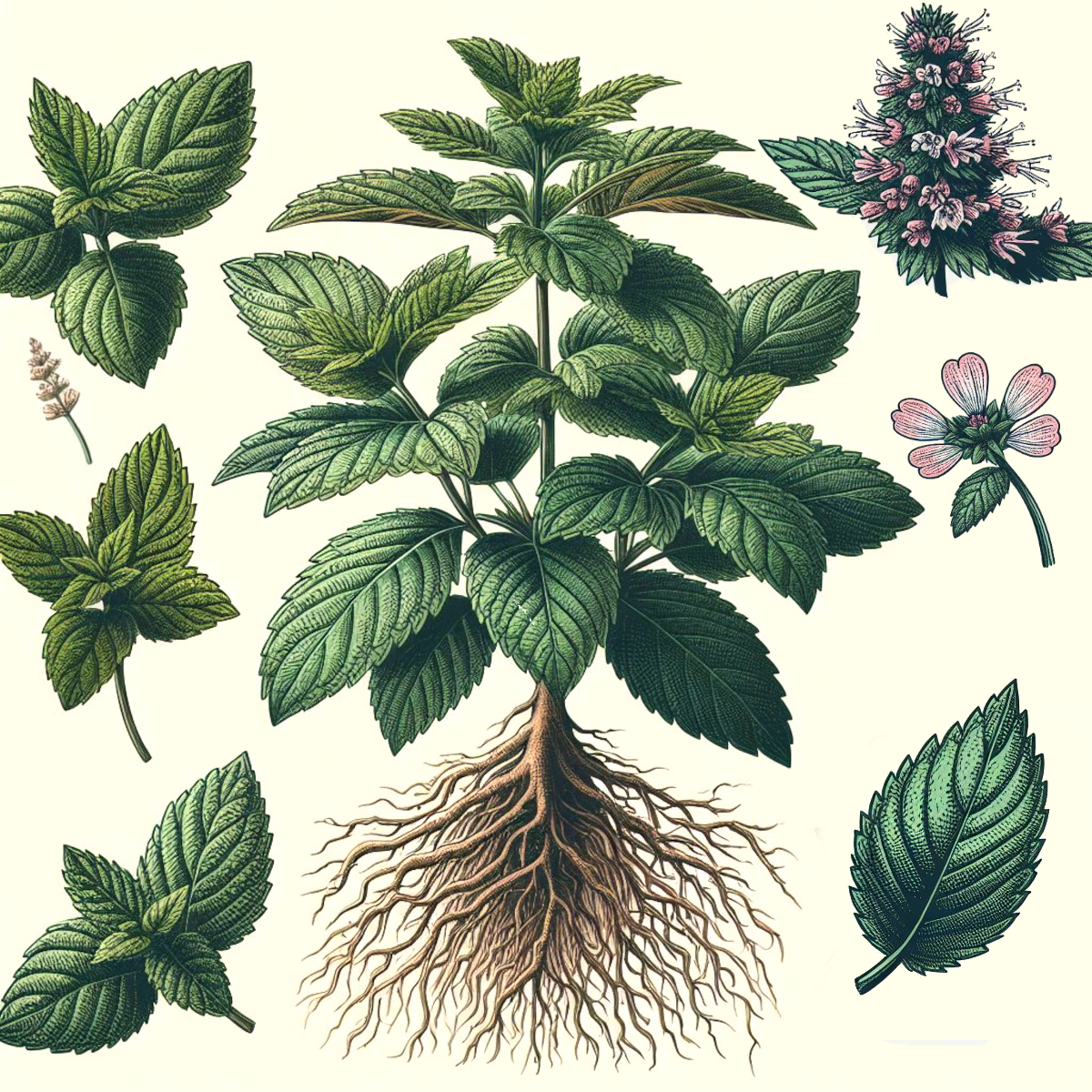
MEDIPLANT | Peppermint (Mentha piperita): Nature’s Cooling Refreshment and Therapeutic Wonder
Introduction:
Peppermint, scientifically known as Mentha piperita, is a beloved herb renowned for its cooling sensation, invigorating aroma, and versatile therapeutic properties. A member of the mint family, Lamiaceae, peppermint has been cherished for centuries for its myriad health benefits, culinary uses, and aromatic allure. In this comprehensive guide, we delve into the botanical characteristics, health-enhancing compounds, therapeutic applications, and culinary delights of peppermint.
Botanical Description:
Peppermint is a perennial herbaceous plant characterized by its square stems, serrated leaves, and clusters of small white to pinkish flowers. It is a hybrid species resulting from the crossbreeding of watermint (Mentha aquatica) and spearmint (Mentha spicata). Peppermint thrives in temperate climates and moist, well-drained soil, with ample sunlight. It propagates readily through its creeping rhizomes, spreading vigorously in garden beds and containers.
Chemical Composition:
The distinctive flavor and therapeutic properties of peppermint are attributed to its rich array of bioactive compounds, including:
- Menthol: Menthol is the primary volatile oil in peppermint, responsible for its cooling sensation and analgesic properties. Menthol acts as a natural topical anesthetic, soothing sore muscles, alleviating tension headaches, and providing relief from minor aches and pains.
- Menthol Esters: Peppermint contains menthyl acetate and menthone, menthol esters that contribute to its refreshing flavor and aroma. These compounds possess mild analgesic and antispasmodic effects, helping to ease digestive discomfort and promote relaxation.
- Terpenes: Peppermint contains various terpenes, including limonene, pinene, and pulegone, which contribute to its aromatic profile and potential health benefits. Terpenes exhibit antioxidant, anti-inflammatory, and antimicrobial properties, supporting overall well-being.
- Rosmarinic Acid: Peppermint is rich in rosmarinic acid, a polyphenolic compound with antioxidant and anti-inflammatory properties. Rosmarinic acid helps protect cells from oxidative damage, reduce inflammation, and support immune function.
- Flavonoids: Peppermint contains flavonoids such as hesperidin and luteolin, which possess antioxidant and anti-inflammatory properties. Flavonoids contribute to peppermint’s potential cardiovascular benefits and overall health-promoting effects.
Health Benefits:
Peppermint offers a wide range of health benefits, including:
- Digestive Relief: Peppermint is prized for its digestive-soothing properties, helping to alleviate symptoms of indigestion, bloating, gas, and abdominal discomfort. Menthol and menthone relax the muscles of the gastrointestinal tract, promoting smoother digestion and relieving spasms.
- Headache Relief: Peppermint’s cooling sensation and analgesic properties make it a popular natural remedy for tension headaches and migraines. Applying diluted peppermint oil to the temples or inhaling its aroma can help reduce headache intensity and duration.
- Respiratory Support: Peppermint’s menthol content acts as a natural decongestant and expectorant, helping to relieve nasal congestion, clear respiratory passages, and alleviate symptoms of colds, coughs, and sinusitis. Peppermint tea or steam inhalation can provide respiratory relief and promote easier breathing.
- Mood Enhancement: Peppermint’s invigorating aroma can uplift the spirits, improve mental clarity, and enhance focus and concentration. Inhaling peppermint essential oil or enjoying a cup of peppermint tea can boost mood and reduce feelings of fatigue or lethargy.
- Oral Health: Peppermint’s antimicrobial properties make it beneficial for oral hygiene and fresh breath. Peppermint mouthwash or toothpaste can help inhibit bacterial growth, prevent plaque formation, and maintain healthy gums and teeth.
Therapeutic Uses:
Peppermint is utilized in various forms for therapeutic purposes, including:
- Peppermint Tea: Peppermint tea is a refreshing herbal infusion made by steeping dried or fresh peppermint leaves in hot water. Peppermint tea is enjoyed for its digestive support, respiratory relief, and soothing effects on the mind and body.
- Aromatherapy: Peppermint essential oil is widely used in aromatherapy for its invigorating scent and therapeutic properties. Diffusing peppermint oil or inhaling it directly can enhance mental clarity, relieve congestion, and promote feelings of alertness and well-being.
- Topical Applications: Peppermint oil can be diluted and applied topically to the skin to soothe sore muscles, alleviate tension headaches, and provide cooling relief from sunburns or insect bites. Peppermint-infused creams, lotions, and balms offer localized comfort and relaxation.
- Culinary Delights: Peppermint leaves are used as a flavorful culinary herb in various dishes, including teas, salads, desserts, and savory recipes. Fresh or dried peppermint leaves add a burst of refreshing flavor and aroma to culinary creations, enhancing both taste and nutritional value.
Precautions and Considerations:
While peppermint is generally safe for most individuals when consumed in moderate amounts, excessive intake of peppermint oil or supplements may cause adverse effects such as heartburn, allergic reactions, or interactions with certain medications. Individuals with gastroesophageal reflux disease (GERD), hiatal hernia, or gallbladder problems should use peppermint with caution, as it may exacerbate symptoms. Pregnant or breastfeeding women and young children should consult with a healthcare professional before using peppermint products. It is advisable to perform a patch test before applying peppermint oil topically to check for skin sensitivity or allergic reactions.
Conclusion:
In conclusion, peppermint (Mentha piperita) stands as a symbol of nature’s cooling refreshment and therapeutic wonder, offering a multitude of health benefits and culinary delights. From its digestive support and headache relief to its respiratory comfort and mood enhancement, peppermint embodies the essence of holistic wellness and natural healing. Whether enjoyed as a soothing cup of peppermint tea, a revitalizing aroma in aromatherapy, or a flavorful addition to culinary creations, peppermint invites us to savor its invigorating essence and embrace the abundance of health and vitality it bestows. As we continue to unlock the secrets of peppermint’s botanical brilliance, we embark on a journey of well-being, vitality, and sensory delight in harmony with the wisdom of nature and the bounty of the earth.